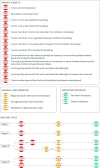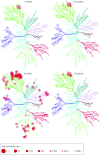Renal cell carcinoma - PubMed (original) (raw)
Review
Renal cell carcinoma
Eric Jonasch et al. BMJ. 2014.
Abstract
The treatment of renal cell carcinoma (RCC) has changed greatly over the past 15 years. Progress in the surgical management of the primary tumor and increased understanding of the molecular biology and genomics of the disease have led to the development of new therapeutic agents. The management of the primary tumor has changed owing to the realization that clean margins around the primary lesion are sufficient to prevent local recurrence, as well as the development of more sophisticated tools and techniques that increase the safety of partial nephrectomy. The management of advanced disease has altered even more dramatically as a result of new agents that target the tumor vasculature or that attenuate the activation of intracellular oncogenic pathways. This review summarizes data from prospective randomized phase III studies on the surgical management and systemic treatment of RCC, and provides an up to date summary of the histology, genomics, staging, and prognosis of RCC. It describes the management of the primary tumor and offers an overview of systemic agents that form the mainstay of treatment for advanced disease. The review concludes with an introduction to the exciting new class of immunomodulatory agents that are currently in clinical trials and may form the basis of a new therapeutic approach for patients with advanced RCC.
© BMJ Publishing Group Ltd 2014.
Conflict of interest statement
Competing interests: We have read and understood BMJ policy on declaration of interests and declare the following interests. EJ: consultant for Aveo, Bayer, GSK, Novartis, and Pfizer; clinical research support from BMS, GSK, Novartis, Pfizer, and Onyx; laboratory research support from Exelixis. WKR: consultant for Aveo (uncompensated), clinical research support from GSK and Seattle Genetics. ); WKR’s husband was funded for a research sabbatical by Novartis pharmaceuticals. JJG: none.
Figures
Fig 1 Incidence of renal cell carcinoma in different geographical regions. Adapted with permission from Cancer Research UK
Fig 2 Which continent has the highest incidence of kidney cancer? Use our interactive tool to find out how cancer incidence varies by population. See
www.bmj.com/content/349/bmj.g4797/infographic
Fig 3 Tumor node metastasis (TNM) staging for renal cell carcinoma (2010 version)
Fig 4 Memorial Sloan Kettering risk criteria. The algorithm includes five factors: hemoglobin below the lower limit of normal, Karnofsky performance status of less than 80, less than one year from diagnosis to start of systemic therapy, corrected calcium above the upper limit of normal, and lactate dehydrogenase more than 1.5 times the upper limit of normal. Patients with a good risk have no risk factors; intermediate risk patients have one or two; and poor risk patients have three or more factors
Fig 5 Kinome profile for axitinib, pazopanib, sunitinib, and sorafenib. The branches represent the known human kinases. Red circles represent targets for the various agents and the size of the circle indicates the inhibitory potency of the kinase (circle sizes are inversely proportional to fold selectivity ratios). Axitinib is an example of a highly specific kinase inhibitor, whereas sunitinib has a considerably broader range of action. Darker red dots provide contrast where overlapping dots are present. Adapted, with permission, from McTigue and colleagues
Fig 6 Overall survival in patients who developed (A) treatment emergent systolic hypertension (>140 mm Hg) and (B) treatment emergent diastolic hypertension while receiving sunitinib. Those who developed hypertension had significantly better overall survival than those who did not. Adapted, with permission, from Rini et al
Similar articles
- Neoadjuvant and adjuvant strategies in renal cell carcinoma: more questions than answers.
Homicsko K, Berthold DR. Homicsko K, et al. Anticancer Drugs. 2011 Jan;22 Suppl 1:S4-8. doi: 10.1097/01.cad.0000390766.47540.07. Anticancer Drugs. 2011. PMID: 21173604 Review. - Renal cell carcinoma: current status and future prospects.
Drucker BJ. Drucker BJ. Cancer Treat Rev. 2005 Nov;31(7):536-45. doi: 10.1016/j.ctrv.2005.07.009. Epub 2005 Oct 17. Cancer Treat Rev. 2005. PMID: 16236454 Review. - Evolving principles of surgical management and prognostic factors for outcome in renal cell carcinoma.
Lam JS, Breda A, Belldegrun AS, Figlin RA. Lam JS, et al. J Clin Oncol. 2006 Dec 10;24(35):5565-75. doi: 10.1200/JCO.2006.08.1794. J Clin Oncol. 2006. PMID: 17158542 Review. - The role of surgery in advanced renal cell carcinoma: cytoreductive nephrectomy and metastasectomy.
Karam JA, Wood CG. Karam JA, et al. Hematol Oncol Clin North Am. 2011 Aug;25(4):753-64. doi: 10.1016/j.hoc.2011.05.002. Hematol Oncol Clin North Am. 2011. PMID: 21763966 Review. - Significance of gene expression analysis of renal cell carcinoma.
Leppert JT, Pantuck AJ. Leppert JT, et al. Expert Rev Anticancer Ther. 2006 Feb;6(2):293-9. doi: 10.1586/14737140.6.2.293. Expert Rev Anticancer Ther. 2006. PMID: 16445381 Review.
Cited by
- Complications of Tumor Nephrectomy with and Without Tumor Thrombus in the Vena Cava, Recorded with the Clavien-Dindo Classification: A Matched-Pair Analysis.
Frölich UM, Leucht K, Grimm MO, Foller S. Frölich UM, et al. Cancers (Basel). 2024 Oct 18;16(20):3523. doi: 10.3390/cancers16203523. Cancers (Basel). 2024. PMID: 39456617 Free PMC article. - N-acetylgalactosaminyltransferase GALNT6 is a potential therapeutic target of clear cell renal cell carcinoma progression.
Sun L, Li Z, Shu P, Lu M. Sun L, et al. Cancer Sci. 2024 Oct;115(10):3320-3332. doi: 10.1111/cas.16296. Epub 2024 Aug 6. Cancer Sci. 2024. PMID: 39105355 Free PMC article. - TPD52L2 as a potential prognostic and immunotherapy biomarker in clear cell renal cell carcinoma.
Wang H, Liu Z, Du Y, Cheng X, Gao S, Gao Y, Shang P. Wang H, et al. Front Oncol. 2023 Nov 23;13:1210910. doi: 10.3389/fonc.2023.1210910. eCollection 2023. Front Oncol. 2023. PMID: 38074636 Free PMC article. - Wogonin Induces Apoptosis and Reverses Sunitinib Resistance of Renal Cell Carcinoma Cells via Inhibiting CDK4-RB Pathway.
Wang Y, Chen S, Sun S, Liu G, Chen L, Xia Y, Cui J, Wang W, Jiang X, Zhang L, Zhu Y, Zou Y, Shi B. Wang Y, et al. Front Pharmacol. 2020 Jul 24;11:1152. doi: 10.3389/fphar.2020.01152. eCollection 2020. Front Pharmacol. 2020. PMID: 32792963 Free PMC article. - ATF3 Suppresses Growth and Metastasis of Clear Cell Renal Cell Carcinoma by Deactivating EGFR/AKT/GSK3β/β-Catenin Signaling Pathway.
Gao S, Gao L, Wang S, Shi X, Yue C, Wei S, Zuo L, Zhang L, Qin X. Gao S, et al. Front Cell Dev Biol. 2021 Mar 19;9:618987. doi: 10.3389/fcell.2021.618987. eCollection 2021. Front Cell Dev Biol. 2021. PMID: 33816467 Free PMC article.
References
- Latif F, Tory K, Gnarra J, Yao M, Duh FM, Orcutt ML, et al. Identification of the von Hippel-Lindau disease tumour suppressor gene. Science 1993;260:1317-20. - PubMed
- Kaelin WG Jr. The von Hippel-Lindau tumour suppressor protein: O2 sensing and cancer. Nat Rev Cancer 2008;8:865-73. - PubMed
- International Agency for Research on Cancer. GLOBOCAN. Kidney—estimated incidence, all ages: both sexes. 2012 http://globocan.iarc.fr/old/summary_table_site-html.asp?selection=10210&....
- Siegel R, Naishadham D, Jemal A. Cancer statistics, 2013. CA Cancer J Clin 2013;63:11-30. - PubMed
- Cancer Research UK. Kidney cancer incidence statistics. 2013. www.cancerresearchuk.org/cancer-info/cancerstats/types/kidney/incidence/....
Publication types
MeSH terms
Substances
LinkOut - more resources
Full Text Sources
Other Literature Sources
Medical
Miscellaneous





